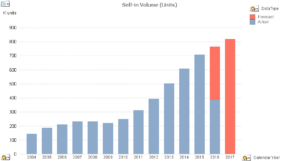
We’re heading towards the end of the quiet summer period, now, and my inbox is filling up with requests for meetings at IBC and IFA – mostly at IBC as there is a much smaller press corps and PRs make an effort to try to get those attending to come to see what their clients are doing. At IFA, most companies expect the main press to come by, so they bother less.
Our front page story in Large Display Monitor is about the Public Display Market in Europe, which continues to grow but with growth slowing down in the most advanced markets. My next job after finishing this week’s issue is to look at the forecast for this sector of the industry, which has been a positive growth market for the 12 years that Meko has been tracking it. In that time, sales have grown from around 140 thousand units to around three quarters of a million sets this year. Apart from a ‘blip’ around the financial crash in 2008/2009, the market has followed a classic ‘S’ curve of growth.
However, last quarter it seemed to me that we were getting towards the second half of the ‘S’ curve, when the growth slows and we start to head towards maturity. This is mainly true in the developed countries of the West of Europe, where digital signage is well established. Normally, I would hope to see the technology diffusing through the rest of the region to the East and the South and MEA, and this was the pattern from 2004 to 2013 (broadly). However, the economic and political problems in Eastern Europe and MEA have really slowed this down and Western Europe is expected to take a bigger share this year, the fourth consecutive annual increase.
However, in the biggest and most established markets of Germany and the UK, we are starting to head towards maturity. The biggest application segment for digital signage is retail and large retailers in these markets are sophisticated, but also cost driven. They want to fight the competition from online, so they need to have more displays, but they also have to watch the bottom line. They often understand the issues of digital signage and will continue to adopt it, but carefully. That means more limited revenue growth than in the past.
Now, the aim in this kind of market is to find a second ‘S’ curve to drive more growth. I would argue that the current digital signage paradigm, which has really been about changing from static, printed signs to video-based, dynamic signage is now well understood. There cannot be a serious retailer that has not tried to use digital signage in this way and they understand the pros and cons.
Arguably, for digital signage, the next ‘S’ curve is to signage that exploits sensor and communication technology to make signage more responsive and customised. Digital signage operators need to make sure that they can either distract consumers from their personal screens, or exploit those screens. There’s still a lot of work to be done to understand how that really is best done.
However, interactivity with digital signage is quite new and is still in the relatively early stages of development. Probably more important, these systems need a very thoughtful approach from retailers based on extremely well organised IT systems and that will mean that only the most sophisticated will be able to exploit the technology. In turn, this means that the impact of these technologies will be relatively small, for now and the additive effects of this second ‘S’ curve will be small for a while.
The slowing growth means that we’ve now got to the point where long term, brands have to choose to “get big, get niche or get out”. Samsung, NEC, LG and Philips (MMD/TPV) are all big enough in share to survive. Sharp has the backing of Foxconn and that may be enough to get them and keep them in the game. For the rest, it looks as though niche strategies are the future.
Bob

